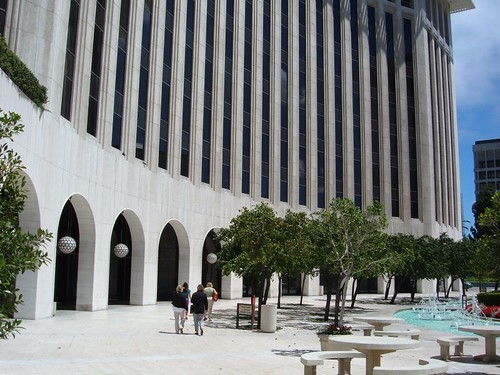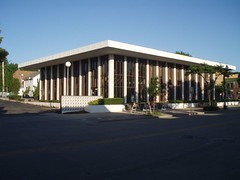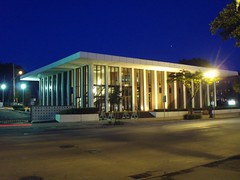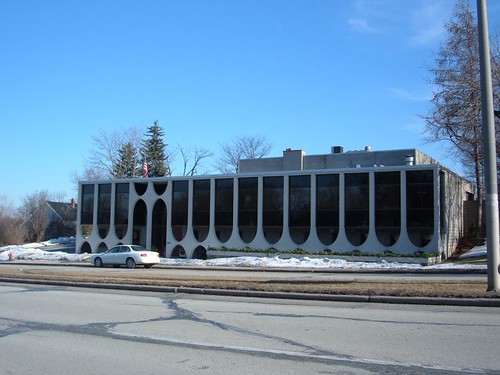(Man, my name for it is totally better!)

Whatever you call it, it was an early reaction against pure Modernism, or at least Modernism's total rejection of historical precedent, and perhaps a distant precursor to Post-Modernism. It attempted to take Modernism's simplified forms and overlay them on aspects of Classical architecture -- rich materials, emphasis on structure, symetrical and axial design. The result was an architecture of polished white marble (or more frequently, concrete painted white), buildings surrounded with arcades of white columns capped with round arches -- or a visual simulation of a columnade, if the budget or site plan wouldn't allow an actual habitable exterior space. Its most noted practioners were Edward Durell Stone and, in one of his periodic stylistic swings, Phillip Johnson; perhaps the most prominent example of the style is New York City's Lincoln Center for the Performing Arts.


There's a pretty stock example on Oakland in Shorewood, a bank and insurance building. It lacks the round arches, but it's got every other standard feature: tall, narrow piers in white, infilled with brown glazed brick and stingily thin windows. A openwork concrete brick wall. Globe lamps in the parking lot. A glass-encased lobby and stairwell, complete with a series of lamps artfully hung at varying heights.

Brown glazed brick! Who ever thought up such a thing? The darker materials of the infill helps it "disappear", creating the desired "arcade" effect.
Another little example stands out on on the southwest fringes of the city -- I want to say Green Bay Road, but it's been so long I don't remember for sure.

There's another little example up on Brown Deer Road at I-43, and a whole corporate campus in the style out by Brookfield Square Mall.
Overall, it's a widely under-appreciated style, particularly as it's about four decades old -- the age at which old architectural styles always look their worst to contemporary eyes. Even I can't help seeing it as a bit dry, stiff and stodgy somehow, but it also has a certain amount of beauty as well.
Milwaukee has recently lost two examples to remodelings -- a downtown office building on Wisconsin Avenue, re-skinned in 2004, and the Amtrak station (which had a neat exterior but needed a new interior in the worst way.) It's enough to make me perk up -- it would be unfortunate if all traces of the short-lived movement vanished from Milwaukee completely.
3 comments:
If the building you think is on the southwest side of town is indeed from there, and I think it is, it is on Forest Home between 84th St and Hwy 100 (nearish to 92nd St).
I used to pass that regularly on my bike ride to work near Southridge.
"Milwaukee has recently lost two examples to remodelings -- a downtown office building on Wisconsin Avenue, re-skinned in 2004, and the Amtrak station (which had a neat exterior but needed a new interior in the worst way.) It's enough to make me perk up -- it would be unfortunate if all traces of the short-lived movement vanished from Milwaukee completely."
I'm sorry but I couldn't disagree more. This is horrible architecture and the train station was hidious. Thank God somebody had enough common sense to get rid of any trace of that horrid bland supposed architecture.
Thank God somebody had enough common sense to get rid of any trace of that horrid bland supposed architecture.
That's almost word-for-word what they said in the 1950s as they bulldozed ornate Victorian mansions. Just add in "obsolete", "dark" and "heavy".
So, careful what you wish for! One generation's "garbage" is another's ladnmark.
Post a Comment